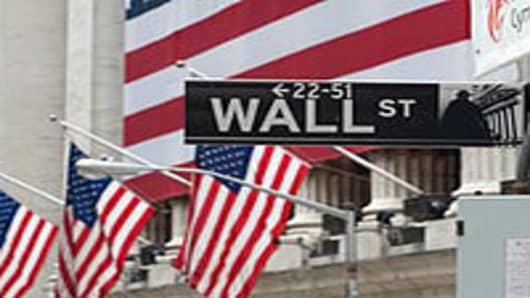The stars are aligned for a major asset allocation shift that has investors dumping bonds and giving stocks a second look, as interest rates move higher.
That trade was apparent Tuesday, as the Dow rose 47 points to 11,476, while the S&P 500 edged up just a point to 1241. At the same time, bonds took a drubbing, and the yield on the 10-year note shot to 3.45 percent, from 3.28 Monday, as the Fed reaffirmed its intention to purchase $600 billion in Treasury securities in its quantitative easing program.
"November marked the first time in 22 months that we started to see (bond fund) outflow data, and we're obviously seeing an asset allocation shift away from bonds and we're seeing it into equities and weirdly we're seeing it into money market funds. What investors are doing is a bar bell trade. They're buying risky assets - equities - and they're buying the safest asset - money markets," said Jim Caron, Morgan Stanley head of global interest rate strategy.
"The starting point of the bond sell off was about two years worth of an overweight position in bonds funds," he said. Caron said the bond selling accelerated once the markets saw the promise of fiscal stimulus in the tax package compromise, and Wall Street economists began ratcheting up their growth forecasts as a result.
Rates have been rising since October, and picked up steam as the Fed began its quantitative easing program in November. The move is contrary to the intent of the program, which in theory was expected to reflate assets while driving rates lower. But the 10-year yield rose more than 100 basis points in that time frame, and Tuesday's move was particularly dramatic.
"It's an inflection point in terms of behavior in the markets.. There's only so much pain people can take. After today, I think a lot of people are going to rethink this. Once the asset allocation begins, it's like turning a tanker in a harbor. Once that momentum starts, it's hard to stop it," Caron said.
The rise in rates is double-edged. For instance, the Fed's effort to push rates lower has failed, and mortgage rates will rise as a result of the higher Treasury yields. Stock market traders also say there will be a level where the higher yields start to threaten the stock market's gains.
A confluence of factors drove Wednesday's markets. Stronger-than-expected producer price inflation data and a better retail sales report were followed by comments from the Fed that the economy continues to be too weak and that it will proceed with its easing measures. Retail sales for November were up 0.8 percent and J.P. Morgan, Morgan Stanley and Credit Suisse were among firms that raised fourth quarter GDP forecasts as a result.
One risk manager said hedge funds were on the wrong side of the trade, and the markets are reflecting lot of repositioning. "Risk assets are rallying so that would imply more positives. There's a rotation out of fixed income into equities. Some sell-side dealers are upping their GDP forecasts, so it's probably a more positive indication, I would think, until rates back up too much," said the manager.
But it's too early to call it a longer term trend. "Look at the last two years. There was a huge rotation out of equities into fixed income and credit. It's a short term reversal. We'll see," she said.
Priya Misra, head of U.S. rates strategy research at Bank of America Merrill Lynch, said she believes part of the recent back up in interest rates was the result of the huge position overhang. "I do think the market could sell off more.. It's not fundamental," she said at a press briefing on the firm's 2011 outlook.
On Wednesday, consumer price data, and the Empire State survey are released at 8:30 a.m. Treasury capital flows data for October is released at 9 a.m. and industrial production for November is reported at 9:15 a.m. The National Association of Home Builders survey is issued at 1 p.m.
The Irish parliament votes Wednesday on the IMF/European Union bailout plan. Investors will also be taking a look at the Japanese tankan survey which showed Japanese business sentiment worsened for the first time in nearly two years this quarter.
Year Ahead
Bank of America Merrill Lynch issued its forecast for 2011 at a press briefing Tuesday morning. Strategists painted a scenario where rising rates later in the year would result in investors moving money next year from bond funds, with equities as the major beneficiary.
Chief U.S. equities strategist David Bianco said he expects 2011 to be a good year for stocks, and like other firms, the B of A strategists had stocks as a favorite asset class. His target is 1400 for the S&P 500.
"We're all going to like equities a lot more," he said. Bianco said there will be record profits for the S&P 500 in 2011, and he is forecasting $93 earnings per share for the S&P 500. That coupled with relatively low interest rates is bullish for stocks.
Bianco also emphasized that the U.S. consumer, while a major driver of the economy, is not necessarily a big driver of the S&P 500. Less than 15 percent of the S&P profits come from consumer discretionary spending. "The consumer is not the end all and be all for the S&P 500," he said.
He noted that energy, the world's biggest commodity, is a big contributor to S&P earnings. "Higher commodity prices almost always lead to higher stock prices," he said. Tech, materials, industrials and energy are his favorite sectors.
- Follow me on Twitter @pattidomm.
Questions? Comments? Email us at marketinsider@cnbc.com



